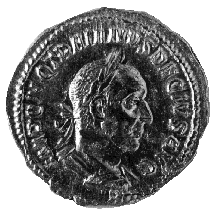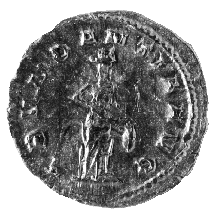



(119) Trajan Decius - AV aureus, A.D. 249-251, 4.05 g. (inv. 91.222).
Obverse: Laureate and cuirassed bust of Trajan Decius r.; IMP(ERATOR) C(AIVS)
M(ESSIVS) Q(VINTVS) TRAIANVS DECIVS AVG(VSTVS): Imperator Gaius Messius
Quintus Traianus Decius Augustus.
Reverse: Abundantia standing r., emptying cornucopia held in both hands;
ABVNDANTIA AVG(VSTI): Abundance of the Augustus.
Provenance: Abner Kreisberg, 1960.
Bibliography: H. Mattingly, E.A. Sydenham, and C.H.V. Sutherland, The
Roman Imperial Coinage IV.3: Gordian III - Uranus Antoninus (London
1949) 10.
Gaius Messius Quintus Decius was born in Pannonia on the Danube and rose
to high offices under the emperor Philip I. When the troops at the Danubian
frontier revolted, Philip persuaded Decius to defend the border, and when
he succeeded, his own troops proclaimed him emperor. He then marched on
Italy and killed Philip in battle at Verona. He added the name Trajan, probably
because of that emperor's original conquest of the Danubian area. He was
called back to the area by a massive invasion of Goths, and he, his son,
and a large part of his army were killed in battle there in A.D. 251.
Decius' portraits are among the most expressive of the period. He is depicted
as a military man, with short, stipled hair and beard, but his face, with
its deeply lined forehead and sunken eyes, conveys the strain and anxiety
of the times. On the reverse, Abundantia, the personification of abundance,
particularly of grain, pours grain from her cornucopia.
C.L.L.



All contents copyright (c) 1996.
Lawrence University
All rights reserved.